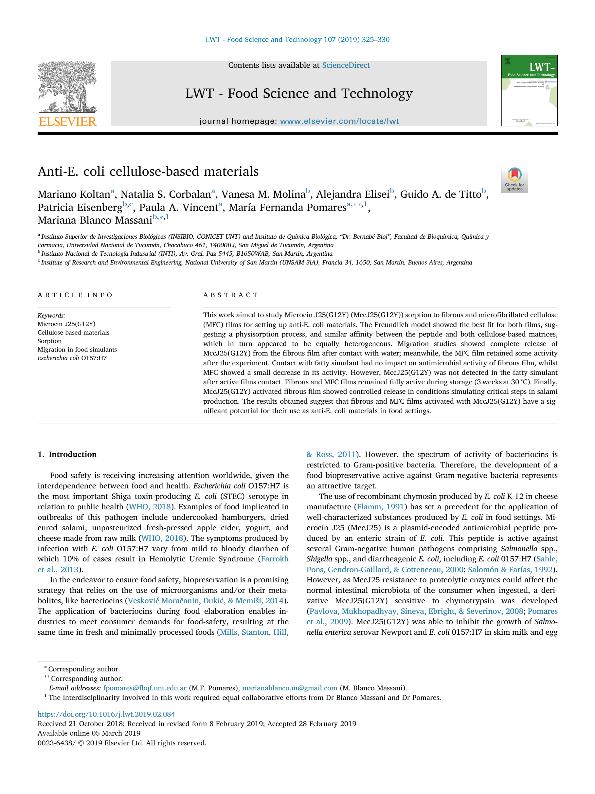Artículo
Anti-E. coli cellulose-based materials
Koltan, Mariano ; Corbalan, Natalia Soledad
; Corbalan, Natalia Soledad ; Molina, Vanesa Magali; Elisei, Alejandra; de Titto, Guido Andrés; Eisenberg, Patricia; Vincent, Paula Andrea
; Molina, Vanesa Magali; Elisei, Alejandra; de Titto, Guido Andrés; Eisenberg, Patricia; Vincent, Paula Andrea ; Pomares, Maria Fernanda
; Pomares, Maria Fernanda ; Blanco Massani, Mariana Raquel
; Blanco Massani, Mariana Raquel
 ; Corbalan, Natalia Soledad
; Corbalan, Natalia Soledad ; Molina, Vanesa Magali; Elisei, Alejandra; de Titto, Guido Andrés; Eisenberg, Patricia; Vincent, Paula Andrea
; Molina, Vanesa Magali; Elisei, Alejandra; de Titto, Guido Andrés; Eisenberg, Patricia; Vincent, Paula Andrea ; Pomares, Maria Fernanda
; Pomares, Maria Fernanda ; Blanco Massani, Mariana Raquel
; Blanco Massani, Mariana Raquel
Fecha de publicación:
06/2019
Editorial:
Elsevier Science
Revista:
LWT - Food Science and Technology
ISSN:
0023-6438
Idioma:
Inglés
Tipo de recurso:
Artículo publicado
Clasificación temática:
Resumen
This work aimed to study Microcin J25(G12Y) (MccJ25(G12Y)) sorption to fibrous and microfibrillated cellulose (MFC) films for setting up anti-E. coli materials. The Freundlich model showed the best fit for both films, suggesting a physisorption process, and similar affinity between the peptide and both cellulose-based matrices, which in turn appeared to be equally heterogeneous. Migration studies showed complete release of MccJ25(G12Y) from the fibrous film after contact with water; meanwhile, the MFC film retained some activity after the experiment. Contact with fatty simulant had no impact on antimicrobial activity of fibrous film, whilst MFC showed a small decrease in its activity. However, MccJ25(G12Y) was not detected in the fatty simulant after active films contact. Fibrous and MFC films remained fully active during storage (3 weeks at 30 °C). Finally, MccJ25(G12Y) activated fibrous film showed controlled release in conditions simulating critical steps in salami production. The results obtained suggest that fibrous and MFC films activated with MccJ25(G12Y) have a significant potential for their use as anti-E. coli materials in food settings.
Archivos asociados
Licencia
Identificadores
Colecciones
Articulos(INSIBIO)
Articulos de INST.SUP.DE INVEST.BIOLOGICAS
Articulos de INST.SUP.DE INVEST.BIOLOGICAS
Citación
Koltan, Mariano; Corbalan, Natalia Soledad; Molina, Vanesa Magali; Elisei, Alejandra; de Titto, Guido Andrés; et al.; Anti-E. coli cellulose-based materials; Elsevier Science; LWT - Food Science and Technology; 107; 6-2019; 325-330
Compartir
Altmétricas



